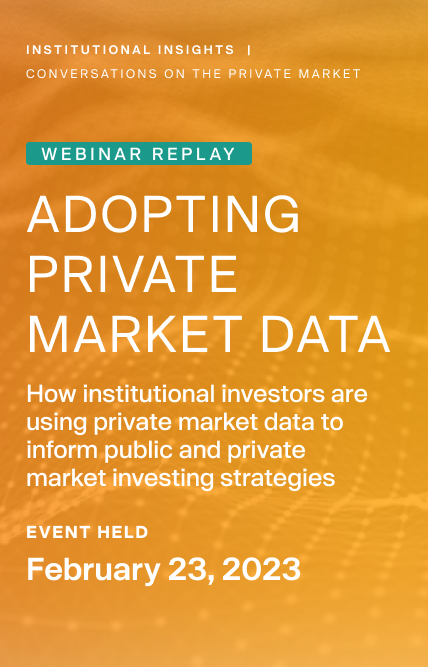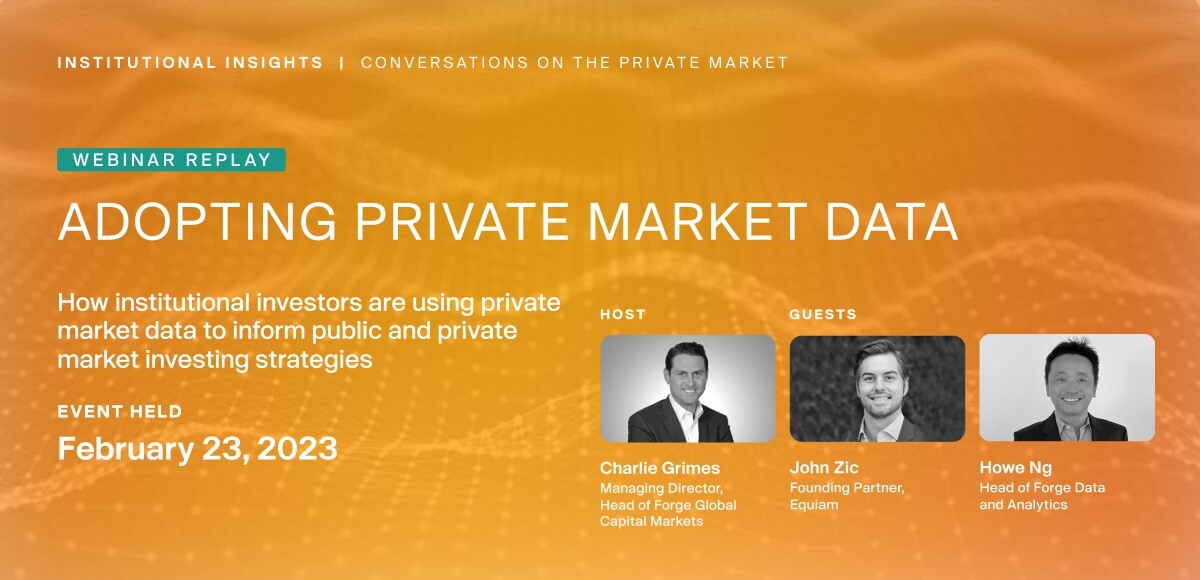Adopting Private Market Data
Institutional investors are increasingly turning to the private market to seek potentially excess returns and differentiate their investment approach from their peers. Many hedge funds, family offices, and VCs are using private secondaries in their asset allocation today. Experienced public market investors may recognize the potential of the private market, yet may encounter challenges building initial private market positions due to a lack of familiarity with the increasing availability of same-day data.
Topics covered:
- How private market data can enhance public market investing strategies and make it easier for investors to get started in the private market
- How data-driven, model-oriented systematic investing strategies can be used in the private market
- How to think about private market assets in your asset allocation, and the increasing role of private secondaries in the alternative sleeve of an investment portfolio

With nearly 10 years in the secondary markets, Charlie leads Forge's Global Capital Markets team. Prior to joining Forge, Charlie spent seven years with SharesPost as a Managing Director. Earlier in his career, Charlie was an advisor at PIMCO, where he was responsible for raising assets and diversifying company investment management exposure beyond traditional core fixed income.

John is a Founding Partner at EQUIAM. He currently oversees the execution of EQUIAM's investment strategy across the firm's three active funds. John has more than a decade of data science experience which he applies daily to the on-going optimization EQUIAM's proprietary G.E.N.I.U.S. model. John is a member of EQUIAM’s Investment Committee.

Howe Ng leads data and analytics at Forge overseeing the research & development of market insights, investment research and product analytics. Howe has more than 18 years of buy-side institutional asset management experience. He previously held roles in systematic active equity portfolio management and ETF product strategy at BlackRock and additional leadership roles at Nipun Capital and Barclays Global Investors.

Karan is the Co-Head of Marketplace for Forge, which he joined as an early employee in 2018. Previously, Karan was at Bank of American Merrill Lynch, in their Equity Capital Markets division. He has extensive experience in capital markets, having completed >$10B in transaction volume across various assets classes including secondaries, IPOs, follow-ons and SPACs.

Sally serves major institutional clients for Forge Global Capital Markets. Sally has over 5 years in the secondary markets with Forge and SharesPost. Prior to joining SharesPost, Sally spent 3 years with Bank of America Merrill Lynch.
Transcript
Hello. And welcome to today's event. I'm Charlie Grimes, Managing Director and Head of Global Capital Markets at Forge. We're excited to have you join us today. Thank you for taking the time. I think we can all agree that markets acted a lot differently in 2022 than they did in the two years prior.
And thankfully, we're not here today to discuss macroeconomics or debate fed policy. At Forge, we are committed to helping private market investors focus on 2023 and beyond. Because now that the calendar has turned, and markets look to find their footing, investors we are speaking with are taking a fresh look at opportunities in the private market. As I'm sure you are all aware, Forge specializes in helping institutional investors access the private market.
We have helped thousands of clients transact billions of dollars in private shares. And we understand how challenging it can be to truly dig into the private market and access meaningful, high-quality data. Because the private market has long been considered opaque, it has lacked so much of the data that is available to investors in the public markets, including data from the company's issuing the stock. Data like bids and asks from buyers and sellers and even the most basic data on executed trades like stock price and volume.
But that's changing. And Forge Data is leading the way by providing investors with private market trading data that allows them to build confidence when conducting research and evaluating private market investments. And so, it's fitting that today's event is called adopting private market data. Today, we are going to look at how institutions are using private market data to inform public and private investing strategies.
Our goal for today's conversation is to illustrate how Forge is working to increase transparency and provide our clients with as much information as possible to make investment and portfolio management decisions. In a few minutes, we'll bring you a conversation with John Zic, a founding partner at Equiam. Equiam is a private market investment firm that uses systematic investing strategies to build portfolios. You'll hear a lot of similarities in that conversation between public market investing strategies and their private market strategy.
But first, I sat down with two of Forge’s institutional leaders, Howie Ng and Sally Mace, for a conversation on how investors are using private assets in their portfolios, how data can be used to make investment decisions and share some insight into what Forge is hearing about private market data from our institutional clients today.
Hello. And welcome to today's event. I'm Charlie Grimes, Managing Director and Head of Global Capital Markets at Forge. We're excited to have you join us today. Thank you for taking the time. I think we can all agree that markets acted a lot differently in 2022 than they did in the two years prior.
And thankfully, we're not here today to discuss macroeconomics or debate fed policy. At Forge, we are committed to helping private market investors focus on 2023 and beyond. Because now that the calendar has turned, and markets look to find their footing, investors we are speaking with are taking a fresh look at opportunities in the private market. As I'm sure you are all aware, Forge specializes in helping institutional investors access the private market.
We have helped thousands of clients transact billions of dollars in private shares. And we understand how challenging it can be to truly dig into the private market and access meaningful, high-quality data. Because the private market has long been considered opaque, it has lacked so much of the data that is available to investors in the public markets, including data from the company's issuing the stock. Data like bids and asks from buyers and sellers and even the most basic data on executed trades like stock price and volume.
But that's changing. And Forge Data is leading the way by providing investors with private market trading data that allows them to build confidence when conducting research and evaluating private market investments. And so, it's fitting that today's event is called adopting private market data. Today, we are going to look at how institutions are using private market data to inform public and private investing strategies.
Our goal for today's conversation is to illustrate how Forge is working to increase transparency and provide our clients with as much information as possible to make investment and portfolio management decisions. In a few minutes, we'll bring you a conversation with John Zic, a founding partner at Equiam. Equiam is a private market investment firm that uses systematic investing strategies to build portfolios. You'll hear a lot of similarities in that conversation between public market investing strategies and their private market strategy.
But first, I sat down with two of Forge’s institutional leaders, Howie Ng and Sally Mace, for a conversation on how investors are using private assets in their portfolios, how data can be used to make investment decisions and share some insight into what Forge is hearing about private market data from our institutional clients today.
And in some sort of taking all of this together, I think what our trading desk and the data offers is great insight into how companies are trading, where buyers and sellers are positioned in the market and how to sort of think through and get smart on the topic. How we, Sally, thank you so much. That was a great conversation.
I’m here with Howie Ng, Forge’s Head of Data and Analytics and Sally Mace, a Senior Director on Forge’s Institutional Markets desk. Today, we're going to dive into how institutions are using private market data to better understand the space, make investment decisions, and also learn a little bit more about current sentiment from the institutional investors in today's market. Howe, let's start with you. I think it's fair to say the mood amongst investors on our platform seems to be cautiously optimistic.
Inflation numbers are showing signs of improvement, but things still remain elevated. On the other hand, economic data remains strong, so we aren't seeing signs of a recession out there. Now you've spent 18 years on the buy side with most of that time at BlackRock. And since joining Forge, you've connected with dozens of buy side investors, hedge funds, VCs, portfolio managers, traders, what are you hearing from them regarding their current view of the private market?
Thanks, Charlie. And thank you for the question.
It is a timely question, particularly in the current environment. So, to answer your question directly, it really depends on the investors, though the overarching theme is that they investors on our platform are increasingly data driven in their decision making process. Of the firms that I've spoken with, investors that are nimbler and have more discretion in their investment policies, they are curious about the potential opportunities in this asset class, and are looking to formulate new strategies.
I get the sense that they want to do this quickly and effectively, given potential buying opportunities. Now, some of the larger institutions that I've spoken with, particularly those already invested in the asset class, are looking for new ways to enhance their investment process - from researching new alpha signals to better ways to mark to market their private exposure. So, as we know, IPO or exit events are few and far between nowadays. The interesting trend that I see is that as companies stay private longer and trading activities of private secondaries increase, the liquidity profile and potential investment opportunities improve substantially.
And this is good news for investors who are looking for new sources of potential return and diversification. And when I speak to asset allocators, they talk about the challenges of a traditional 60/40 portfolio, how it is getting more difficult to generate excess return given the increased correlation among traditional asset classes, as well as how fast information and data get arbitraged away in today's environment, particularly in the public markets.
Even for investors currently with an alt allocation, many are just starting to find out more about this unique asset class. While many may have heard of household names such as Airbnb and Palantir and their successful public exits, surprisingly, few have realized that they could actually access those names in the secondary markets prior to exit events. Which leads us to Forge. With access to trading and data, investors can now rethink their investment strategies and change or fine tune their asset allocation models.
Now, you've recently moved into a new role at Forge as head of data and analytics, which means you oversee all of the data and insights in Forge Intelligence and play a key role in helping investors interpret private market data, which is important as this may be new for investors that are used to interpreting data in the public equity markets. So, what does Forge's data show about the current state of the private market right now on the platform? And how can investors use Forge Intelligence to potentially improve their private investing processes?
Thanks, Charlie. Good question again.
Now, being a data person, I have seen many private data offerings in this space. I would say a key feature of our data product is in the way data and insights are curated and structured. It is intuitive and informative to both public and private investors. So, starting at a macro level, investors can get a snapshot of how private market sectors are performing through our Sectors Insights page.
Now, as a previous public market investor, I always want to get a sense of how the overall economy is doing before diving deeper into names with specific sectors. Now, what is unique about our platform is that investors can observe liquidity and performance metrics across private market sectors made possible by the trade and pricing data that we curate. When it comes to specific companies, you can see the full range of pricing data such as bids and asks, volume weighted prices, funding round prices, and mutual fund marks to conduct research, generate new ideas, and formulate or enhance your investment strategies.
Now, if you want to dig in further, you can look at a deeper set of pricing data on specific companies - to inform your view of price discovery, liquidity, valuation, and even relative comparison to public names. Take Dataminr, for instance. It is a unicorn name in the data intelligence sector. Most investors can only see in public sources that its last primary price was $44 a share in early 2021.
But with data from Forge Intelligence, you can observe the continuous price discovery post-2021 through trade, volume, and other market indicators in the secondary market. In addition, we also provide the pricing data points from mutual fund marks. So, you can see how institutional investors are valuing the name over time. And as you know, mutual funds are usually associated with the way institutional investors express their view.
Now, if you want to compare Dataminr to one of its public peers, such as Splunk, you can do that as well, because we do have public equity pricing datasets in our data offering.
Thank you, Howe. Now, Sally, turning to you. You've been with Forge for almost 5 years now, and you've worked with institutional investors throughout many different market cycles as they add to positions, trim existing positions, and generally use the secondary market to manage their portfolios.
Now, last year, Forge saw a reduction in buying activity, as investors dealt with so much volatility out there in the markets. But we're starting to see an uptick in buying activity from investors on our platform. So that begs the question, who is the most engaged in this asset class at the moment? What different investor types are you engaging with daily and weekly? And how are they approaching this market?
Thanks, Charlie.
I think it's a really exciting time with Forge, especially considering our purview into the market covering both the retail segment starting with accredited investors, all the way up into the institutional arm of the business where we're transacting with some of the largest institutional investors and asset managers. When we dig into that institutional client base a bit further, we're certainly seeing traditional VC funds as well as family offices, highly engaged with the market. Both of those can be quite nimble, especially when they're looking at adding to existing positions within their portfolio. ;
Many of the pricing points that we're seeing in the secondary market are meaningfully lower than where some of these funds may have invested in previous rounds over the last few years. So, they're certainly taking advantage of that. We're also seeing both of those client bases active on the sell side as well in select companies where they have potentially invested early on and have achieved meaningful valuation increases over the years.
These buyers are especially focused on businesses that they know quite well and have been tracking for years. Another investor type who remains quite active on our platform is traditional secondaries funds. Many of whom raised meaningful amounts of capital over the last few years. We actually saw traditional secondaries funds were some of the first to step back into the market during the initial part of the pullback and remain quite active buyers on our platform.
Lastly, I'll touch on hedge funds who were a very sizable portion of the buying activity on our platform in 2020 and 2021. While they have certainly pulled back in terms of their buy side activity, they remain quite engaged with the Forge platform both on the trading side as well as the data side of the business and working to understand where markets are actually moving, what the sentiment and the market is and generally tracking this asset class quite closely.
So, Sally, these institutional investors that you're speaking with, what kinds of companies are they targeting? Maybe the sectors, the size of the company, or any other key fundamentals that they're currently looking for?So, I think when you're trying to look at what companies buyers are targeting, it's relevant to the look at both the size of the business as well as the sector.
In terms of size, we're seeing institutional investors focused primarily on the largest segment of the market. So, companies with sort of the 6 to 10 year tenure, companies that have raised multiple rounds of traditional VC funding, and companies that are well positioned to be high quality, strong public businesses as well. Looking at, are they profitable? Are they close to profitability?
I'm hearing from a lot of investors as well that they're looking primarily above all at the quality of the businesses that they're investing in. When it comes to sector, we've seen sort of a more recent trend is focused on artificial intelligence and generative intelligence most recently.
We've also seen sort of a shift away from FinTech and consumer tech and more into sort of traditional SaaS businesses. Charlie Now, we saw at the end of 2022, trades on Forge’s platform were closing in an average of 50% discount to the company's last primary round valuation. So, what are some of the trends in terms of pricing and valuation that you're seeing out there in 2023?
I think that 50% discount speaks to the broader trend of what we're seeing in the market.
And I'll sort of back up just to put that in context. In 2020 and 2021. We were seeing on average companies trading at a premium to their last funding rounds. So, a company would have gone out raised venture funding and almost immediately traded above that valuation in the secondary market. We haven't seen that in well over a year now and that 50% discount is on average what we're seeing relative to companies’ last rounds.
I will say that the most important thing that we're hearing from investors is that they're looking at each company on a case-by-case basis and not applying any sort of broad discount to an entire sector or asset class. There may have been companies that raised well over a hundred X revenue multiple last year. And even if that company is trading at that average 50% discount, it may be still quite over overvalued or too rich for some investors.
So again, it's important to look at each company case by case. A and additionally, considering the illiquidity discount that those investors are expecting on top of that 50% discount that you mentioned, Charlie. So those two factors combined are largely how investors are looking at pricing sort of one relative to their public comps and two the additional illiquidity factor that applies to our asset class.
And in some sort of taking all of this together, I think what our trading desk and the data offers is great insight into how companies are trading, where buyers and sellers are positioned in the market and how to think through and get smart on the topic
So thanks again to Howie and Sally for sitting down with me and sharing their insights with all of us.
Now, before we move on to our next conversation, I wanted to let you know that you can submit questions in the Q&A box below. And we will look to answer some of those questions at the end of the event. Now, we can turn to our second conversation with John Zic. As I mentioned earlier, John is a founding partner at Equiam, a systematic data driven investment fund, bringing elements of quantitative investing used in public markets into the private markets. An Equiam is currently in the process of raising capital for its third fund focused on private market strategies. Karan Arora Co-Head of Marketplace here at Forge recently sat down with John to discuss Equiam’s history, their investing strategy, what John is hearing from their LPs, and share some insight into what a quantitative, systematic investing strategy looks like in the private markets. I hope you enjoy this conversation as much as I did.
That was great. Thanks to John Zic from Equiam for giving us the time and Karan Arora for conducting the conversation. And thanks to everyone for submitting your questions. We're going to get to a couple of these shortly. But before we do that, I wanted to remind our clients that they can reach out to their private market specialists to learn more about Forge Data and how it can be used to track private market transactions.
And for those of you joining us who are new to Forge, welcome, and thank you. And you can reach out to [email protected] and a member of our team will get back to you in short order. Okay, let's move on to a few questions here. Okay. First one for Howe. Howe, can you give us one more quick rundown of the data points in Forge Data and maybe also elaborate on how investors who are familiar with using tools like Bloomberg or FactSet might integrate something like Forge Data?
Sure, Charlie. So, when I think about our dataset, it can be largely grouped into three broad categories: market data, firmographic or sometimes referred to as reference data, and insights and analytics. Specifically, market data - such as trade prices, volume, bids and ask, as well as insights and analytics - built on top of that dataset is something unique that we offer versus most of the data offerings out there.
And when it comes to tools such as Bloomberg and FactSet, I think our dataset can be highly additive in both content, and the ease of integration through the delivery of machine-readable files or API. Our goal is really to make our data pervasive and get them into as many platforms and tools as possible to accelerate the adoption of this asset class.
Thank you, Howe.
Let's see. Second one, we'll stay with you, Howe. You mentioned the challenges of a 60/40 portfolio. And that the investors you're speaking with and I'm looking at increasing some alternative allocations. Have investors on Forge’s platform discuss with you that are using private growth assets versus other alternative investments?
This is a good question.
I would say of the investors that I've spoken to who currently have alts allocation, those who are familiar with the asset class will treat this as the name implies, as the growth portion of their investment strategy. So, think about alongside venture capital exposure. Of the newer or new participants I've spoken with, many are just finding out that they can access this asset class through the secondary market, along with data points and information similar to what they can observe in the public markets such as price discovery and valuation data points that are timely and continuous.
Over time, I think they will formulate new investment ideas and rethink about their allocation to alts.
Makes sense. Okay, thank you, Howe. Let's see. A couple more here. Another one, Sally talked about the average discount to primary rounds previously sitting at around 50%. What part of this reduction in price is due to lower valuations and what might be due to the reduced liquidity of the asset class? I could take this one.
You know, I think it's fair to say that the majority of that discount is due to the changes in valuation, changes in multiples that we're seeing similarly happen in the public markets, are also being, you know, they're flowing through here to the private market. So, you know, hard to put like a 80/20 number on it, but I think it's fair to say the majority of that discount is due to just the valuation changes, not necessarily any liquidity aspects. And I think I see another question here kind of transitions nicely.
If the public markets remain closed for new IPOs, do you anticipate more employees acting as forced sellers? Look, the public markets have been closed for most of the last year, I think. And you know we're not seeing a lot of forced sellers, surely there are some, but the secondary market certainly becomes one of the only options for anyone looking for liquidity.
So we expect it to remain, you know, if not the best option, one of the best options for employees, acting as forced sellers. But I think it's also safe and fair to say that, you know, many shareholders individuals, institutions, are happy to wait for markets to correct as some of our guests talked about today. Adding to new positions taking the opportunity to invest at some of these discounted prices.
So the decision to sell or the decision to access liquidity is uniquely individual and it will depend on the urgency of that individual or maybe that institutional investor to return capital or other decisions that they need to make in their portfolio. So you know it's individuals by seller, shareholder by shareholder and but we expect the secondary markets to remain a great option for shareholders in the private market.
Okay, I think that wraps this up. On behalf of everyone here at Forge, thank you for joining us today and we look forward to speaking with you very soon.
Legal Notices and Disclosures
The opinions expressed are those of the speaker and are subject to change. There is no guarantee the stated results will occur.
The information and material presented in this video is provided for your informational purposes only and does not constitute an offer by Forge to sell, or a solicitation of an offer to buy any securities and may not be used or relied upon in connection with any offer or sale of securities. An offer or solicitation can be made only through the delivery of final offering document(s), purchase agreement(s), and other applicable documentation, and will be subject to the terms and conditions and risks delivered in such documents.
This article does not constitute an offer to provide investment advice or service. Registered representatives of Forge Securities do not (1) advise any member on the merits or prudence of a particular investment or transaction, or (2) assist in the determination of fair value of any security or investment, or (3) provide legal, tax, or transactional advisory services. Securities referenced in this article may be offered by Forge Securities, and certain Forge affiliates may act as principals in such transactions.
Investing In private company securities is not suitable for all Investors. An Investment In private company securities is highly speculative, involves a high degree of risk, and you should be prepared to withstand a total loss of your investment. Private company securities are also highly Illiquid and there Is no guarantee that a market will develop for such securities. Each Investment also carries Its own specific risks and Investors should conduct their own, Independent due diligence regarding the Investment, Including obtaining additional Information about the company, opinions, financial projections and legal or Investment advice. Accordingly, Investing In private company securities Is appropriate only for those Investors who can tolerate a high degree of risk and do not require a liquid Investment.
Past performance is not Indicative of future results.
Legal Notices and Disclosures
The opinions expressed are those of the speaker and are subject to change. There is no guarantee the stated results will occur.
The information and material presented in this video is provided for your informational purposes only and does not constitute an offer by Forge to sell, or a solicitation of an offer to buy any securities and may not be used or relied upon in connection with any offer or sale of securities. An offer or solicitation can be made only through the delivery of final offering document(s), purchase agreement(s), and other applicable documentation, and will be subject to the terms and conditions and risks delivered in such documents.
This article does not constitute an offer to provide investment advice or service. Registered representatives of Forge Securities do not (1) advise any member on the merits or prudence of a particular investment or transaction, or (2) assist in the determination of fair value of any security or investment, or (3) provide legal, tax, or transactional advisory services. Securities referenced in this article may be offered by Forge Securities, and certain Forge affiliates may act as principals in such transactions.
Investing In private company securities is not suitable for all Investors. An Investment In private company securities is highly speculative, involves a high degree of risk, and you should be prepared to withstand a total loss of your investment. Private company securities are also highly Illiquid and there Is no guarantee that a market will develop for such securities. Each Investment also carries Its own specific risks and Investors should conduct their own, Independent due diligence regarding the Investment, Including obtaining additional Information about the company, opinions, financial projections and legal or Investment advice. Accordingly, Investing In private company securities Is appropriate only for those Investors who can tolerate a high degree of risk and do not require a liquid Investment.
Past performance is not Indicative of future results.

